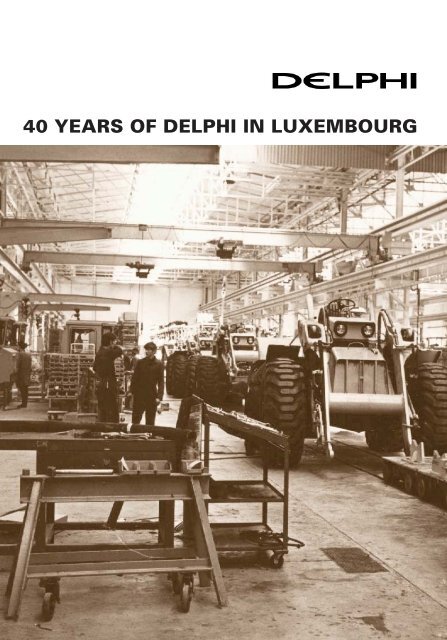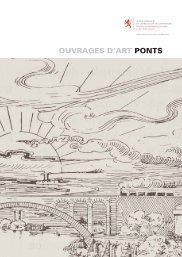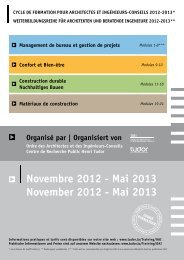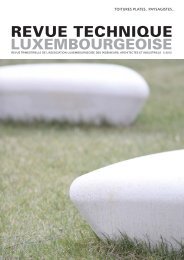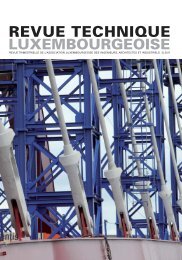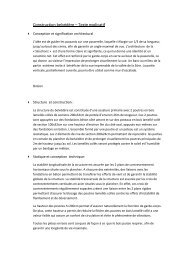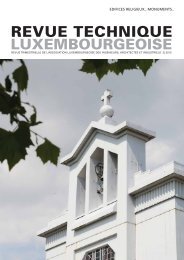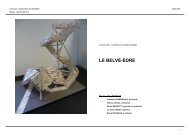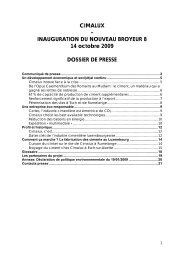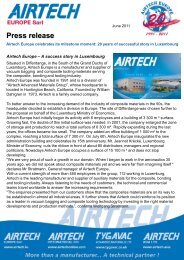40 YEARS OF DELPHI IN LUXEMBOURG - Revue Technique ...
40 YEARS OF DELPHI IN LUXEMBOURG - Revue Technique ...
40 YEARS OF DELPHI IN LUXEMBOURG - Revue Technique ...
You also want an ePaper? Increase the reach of your titles
YUMPU automatically turns print PDFs into web optimized ePapers that Google loves.
<strong>40</strong> <strong>YEARS</strong> <strong>OF</strong> <strong>DELPHI</strong> <strong>IN</strong> <strong>LUXEMBOURG</strong>
2 HORS SERIE #002 | REVUE TECHNIQUE <strong>LUXEMBOURG</strong>EOISE<br />
Dear Delphi employees and friends,<br />
As Minister of the Economy and Foreign Trade of<br />
Luxembourg, I do my outmost to take personal interest<br />
and care of all the companies that make up<br />
the economy of our country. In a globalized world<br />
with economic factors driving the business, a place<br />
like Luxembourg needs to specialize in high valueadd<br />
activities and continuously ensure a favorable<br />
and evolving environment for such operations.<br />
Delphi, no doubt one of the key players in Luxembourg,<br />
is a model of a company that has constantly<br />
adapted over now <strong>40</strong> years to become a dynamic<br />
and competitive state-of-the-art technology center<br />
recognized by all auto makers. I would like to<br />
congratulate all your people for this outstanding<br />
achievement by wishing you a “Happy Birthday<br />
Delphi” and all the best for the future.<br />
Jeannot Krecké<br />
Luxembourg Minister of Economy and Foreign Trade
HORS SERIE #002 | REVUE TECHNIQUE <strong>LUXEMBOURG</strong>EOISE<br />
3<br />
<strong>40</strong> years already !<br />
With the establishment of General Motors in the<br />
Bommelscheuer Industrial Zone, exactly <strong>40</strong> years<br />
ago, a new era was introduced for the commune of<br />
Bascharage.<br />
Under the leadership of the former Mayor, Mr. Robert<br />
Steichen, milestones were placed for an unprecedented<br />
development of the Industrial Zone and the Commune.<br />
To commemorate this event, the Communal<br />
Council decided earlier this year to rename the “Zone<br />
Industrielle Bommelscheuer” in “Economic Activity<br />
Area Robert Steichen”, effective July 1st 2011. This<br />
is to honor the memory and the work done by this<br />
outstanding visionary and to emphasize the development<br />
of the activities of the zone itself.<br />
Over the years, many companies have joined our<br />
commune. First exclusively industrial, the area has<br />
developed and diversified into new niches, including<br />
that of research.<br />
To this end, Delphi, worthy successor of General Motors,<br />
is today one of the examples of our municipality.<br />
With more than 600 people, specialized in automotive<br />
research, Delphi is one of the companies taking<br />
the name of our commune well beyond our country.<br />
That is to be thanked.<br />
Michel Wolter<br />
deputy-mayor of Bascharage
4 HORS SERIE #002 | REVUE TECHNIQUE <strong>LUXEMBOURG</strong>EOISE<br />
Dear Delphi Employees and Friends,<br />
As we celebrate the <strong>40</strong>th anniversary of our Technical Centre in Luxembourg,<br />
it is a good time to recognize the tremendous work done by the<br />
Delphi team here in the automotive heart of Europe. Over the course of<br />
time, this site has continued to evolve and now is one of the company’s<br />
most important technical centres. Luxembourg offers a favorable, commercially<br />
neutral location for major European customers and an attractive<br />
business environment. The central geographical location and the cultural<br />
diversity of our employees allow us to better serve our customers.<br />
Our talented engineers here have developed great technologies to help<br />
make cars safer, greener and better connected.<br />
Automakers around the world are using new advances to address these<br />
Safe, Green and Connected trends with technologies that are innovative,<br />
reliable, cost-effective and address real-world problems. Delphi is<br />
at the forefront of these advances. Our technical expertise and heritage<br />
of innovation in Luxembourg and around the world help us create<br />
the right products, with the right quality, at the right price and at the<br />
right time for our customers and global markets. We are pursuing our<br />
strong commitment to research and development to address challenges<br />
and opportunities. And we continue to differentiate ourselves from our<br />
competitors by securing business with some of the most highly regarded<br />
vehicle manufacturers worldwide.<br />
Delphi is perfectly positioned with a product portfolio that addresses<br />
market trends with the design, engineering and manufacturing excellence<br />
that global customers require, a lean cost structure and an unmatched<br />
global footprint to compete in every region of the world. And<br />
Delphi considers Luxembourg as a performing business location for research<br />
and development activities.<br />
But I know that our true strength is our people. Through your efforts,<br />
we are meeting the challenges of a global market while becoming more<br />
efficient and effective.<br />
We can all be proud of our history and the innovations this site has<br />
pioneered. I am pleased to celebrate this anniversary with you and look<br />
forward to the great work yet to come. Thank you!<br />
Steve Kiefer<br />
President, Delphi Powertrain Systems
HORS SERIE #002 | REVUE TECHNIQUE <strong>LUXEMBOURG</strong>EOISE<br />
5<br />
HORS SERIES DE LA REVUE TECHNIQUE <strong>LUXEMBOURG</strong>OISE<br />
#001 Inauguration forum da Vinci<br />
#002 <strong>40</strong> years of <strong>DELPHI</strong> in Luxembourg<br />
REVUE TECHNIQUE <strong>LUXEMBOURG</strong>EOISE<br />
www.revue-technique.lu<br />
rédacteur en chef Michel Petit<br />
responsable Sonja Reichert<br />
graphisme Bohumil Kostohryz<br />
t 26 11 46 42 revue@aliai.lu<br />
revue trimestrielle éditée par<br />
L’Association Luxembourgeoise des Ingénieurs, Architectes et Industriels<br />
L - 1330 Luxembourg 6, boulevard Grande-Duchesse Charlotte<br />
t 45 13 54 f 45 09 32
6 HORS SERIE #002 | REVUE TECHNIQUE <strong>LUXEMBOURG</strong>EOISE<br />
Delphi’s Customer Technology Centre (CTC) in Bascharage will celebrate this year the <strong>40</strong>th anniversary of Delphi’s<br />
presence in Luxembourg which dates from Oct. 7, 1971. The current site, which opened in 1982, is Delphi’s Europe,<br />
Middle-East and Africa regional headquarters, Powertrain Systems divisional headquarters as well as headquarters<br />
for the European Thermal Business Unit. As the “Automotive Heart of Europe,” Luxembourg hosts one of the company’s<br />
most important European technical centres. 500 engineers and technicians develop automotive energy and<br />
engine management systems, as well as automotive thermal systems and electronics.<br />
<strong>40</strong> <strong>YEARS</strong> <strong>OF</strong> <strong>DELPHI</strong> <strong>IN</strong> <strong>LUXEMBOURG</strong>_<br />
<strong>DELPHI</strong> <strong>LUXEMBOURG</strong>, THE HISTORY<br />
_1970-1971 The Luxembourg site is inaugurated<br />
The Luxembourg site was created on Feb. 25, 1970, when<br />
General Motors Luxembourg S.A. was incorporated as a<br />
subsidiary of General Motors Corporation to manufacture<br />
and sell TEREX earthmoving equipment.<br />
_1971-1978 The production of Terex (General Motors)<br />
The production of TEREX began on May 18, 1971. Initially,<br />
approximately 100 people worked at the Terex site. From<br />
May 1971 to December 1978, the company produced and<br />
sold Terex earthmoving equipment – four front-end loaders<br />
and two types of rear dump trucks, such as the R-35 and<br />
the R-33-19.<br />
Production was stopped in 1978 as business declined and<br />
factoring activity ceased for economical reasons (especially<br />
due to the depreciation of the pound sterling and U.S. dollar).<br />
All except 30 employees were separated, the equipment<br />
was sold to GM Scotland and plans were made for<br />
new activity at the site.<br />
The site was inaugurated on Oct. 7 1971, and many famous<br />
representatives of royal families (such as S.A.R. Prince<br />
Charles and S.A.R. Princess Joan), and political and economical<br />
sectors took part in the event.<br />
_1979-1987 General Motors Luxembourg Operations S.A.<br />
The Luxembourg operation became General Motors Luxembourg<br />
Operations (GMLO) S.A. in July 1979. The facility
HORS SERIE #002 | REVUE TECHNIQUE <strong>LUXEMBOURG</strong>EOISE<br />
7<br />
produced special tooling, such as jigs and fixtures, presses,<br />
welding equipment, conveyor belts, automatic machines<br />
and robots for the GM European Assembly Plants. From<br />
1981 to 1987, GMLO also manufactured components (f.ex.<br />
fuel pumps) and expanded its business to outside customers<br />
in an attempt to provide a more balanced workload for<br />
the production departments. The production of Jigs and<br />
Fixtures ceased in 1987 and GM Luxembourg started its reconversion<br />
by selling its production and equipment.<br />
_May 1981: The inauguration of GMLO<br />
_May 1985 Inauguration of the European Technical Centre (ETC)<br />
In May 1985, the European Technical Centre was inaugurated<br />
at Luxembourg. S.A.R. Grand Duc Henri and many<br />
famous representatives from political and economical sectors<br />
participated in the inauguration.<br />
The new installations of General Motors Luxembourg were<br />
inaugurated on May 13, 1981, followed by an open house<br />
on May 16. This open house included a tour of the facilities,<br />
video shows and an exhibition of GM vehicles. About 150<br />
guests - featuring top American and Luxembourg’s business,<br />
economic, political and social representatives as well<br />
as representatives from the European plants of General Motors<br />
- attended.<br />
_1982: Start of the Technical Centre Activities in Luxembourg<br />
In 1982, the technical centre activity was created within<br />
GMLO to provide a unique source for the supply of advanced<br />
technology design. This activity was given different<br />
names, but eventually was called ESEC (European System<br />
Engineering Centre) to highlight the European activities of<br />
the site. This was in response to the needs of various divisions<br />
of the electrical components group (such as Delco<br />
Electronics, created in 1982) to have a European presence<br />
and share in the expanding market of sophisticated engine<br />
and emission control systems.<br />
_1988 - 1993 A new orientation<br />
In 1988, the General Motors Corporation formed a group<br />
called ACG (Automotive Component Group) to provide<br />
central coordination of the components supply divisions of<br />
General Motors. The ETC in Luxembourg became part of<br />
this group.<br />
The site continued its transformation into a technical centre:<br />
Following the first phase of the technical centre in 1983,<br />
the expansion project was approved in 1989. In April 1990,<br />
the company began a 2 billion FLUX expansion (particularly<br />
in thermal testing and engine testing facilities) to enable the<br />
site to become a complete and fully-focused technical centre.<br />
With wind tunnels, the EMI/RFI chamber, test cells and the<br />
tool lab expansion, the size of the facility was doubled.<br />
_Jan. 1992 – Feb. 1993 Construction of the wind tunnels<br />
Two wind tunnels were built: the Thermal Management<br />
System tunnel (TMS) to support thermal system development,<br />
and the Engine Management System tunnel (EMS).<br />
The Climatic Wind Tunnels allow development of engine<br />
and thermal management systems and emissions measurement<br />
under extreme environmental conditions. The main<br />
challenge of the construction was to integrate the wind<br />
tunnels in an existing building.
8 HORS SERIE #002 | REVUE TECHNIQUE <strong>LUXEMBOURG</strong>EOISE<br />
_1999 An Independent Delphi<br />
On Aug. 3, 1998 General Motors Corporation and its Delphi<br />
Automotive Systems division jointly decided to make<br />
Delphi an independent group. Delphi became a publicly<br />
traded company in 1999. But the path to independence<br />
from General Motors really began in 1994 with the establishment<br />
of Delphi as a separate business sector within<br />
General Motors.<br />
_Jan. 29, 2007 - Delphi Powertrain Headquarters Grand<br />
Opening<br />
In May 2006, Delphi announced its decision to relocate<br />
the global headquarters of its Powertrain division to Luxembourg.<br />
Delphi Corporation officially opened the global<br />
headquarters of its Powertrain division in Luxembourg on<br />
Jan. 29, 2007. “We are dispersing our leadership globally to<br />
manage our business”, Delphi’s Executive Chairman said at<br />
the time. “We are committed to Europe and to supporting<br />
our local customers and we expect to continue our track<br />
record of growth in the region.”<br />
Minister Jeannot Krecké, minister of Economy and Foreign<br />
Trade of Luxembourg, welcomed the Delphi division’s<br />
global headquarters to the country. “Delphi is in fact casting<br />
a vote of confidence for Luxembourg as a performing<br />
business location for research-driven, cutting-edge technological<br />
solutions for one of the most demanding markets,<br />
namely the automotive sector,” he said.<br />
Delphi’s CTC Luxembourg is now part of Delphi Automotive LLP,<br />
which was created in October 2009 when a group of private<br />
investors acquired assets of the former Delphi Corporation.<br />
The site concentrates specifically on design, development<br />
and test of components, sub-systems and systems related<br />
to Energy and Engine Management Systems as well as<br />
Heating, Ventilating and Air Conditioning Systems and the<br />
development of the required power and control electronics,<br />
as well as the energy storage for hybrid and electric<br />
vehicles. From Bascharage, all European customers can be<br />
served and work for vehicle manufacturers also can be undertaken<br />
on a global basis. The geographical location of<br />
Luxembourg in the centre of Europe also is an important<br />
benefit. The Luxembourg workforce has a total of 27 different<br />
nationalities and 18 languages can be spoken.<br />
The site is Delphi’s Middle-East and Africa regional headquarters,<br />
Powertrain Systems Divisional Headquarters as well as<br />
headquarters for the European Thermal Business Unit.<br />
_The Facilities of Delphi Luxembourg<br />
The Luxembourg site is fully equipped to design, develop,<br />
simulate, test and validate products from the component<br />
level up to the vehicle level. Hundreds of specific component<br />
test stands for thermal cycling, noise, vibration and<br />
performance characterization are available for component<br />
development. Two model shops and the large garage are<br />
equipped with tooling and assembly machinery to build<br />
components and install them in vehicles. At the system<br />
level, the site is equipped with module test stands and engine<br />
dynamometers able to simulate the entire lifecycle of<br />
the system. Finally, large vehicle evaluation equipment is<br />
available to perform real-life testing of vehicles under all<br />
conditions, such as noise, electromagnetic compatibility,<br />
emissions, comfort and drivability evaluation. This includes<br />
cold chambers and an external test track with pass-by noise<br />
measurement facility. The operation is supported by a material<br />
laboratory and a large electronics facility able to develop<br />
complete electronic hardware and software for production<br />
vehicle application.<br />
Testing and verification in the Electromagnetic Compatibility<br />
Chamber (EMC) ensures excellent operation of Delphi<br />
systems and components in the presence of strong electromagnetic<br />
disturbances. Emissions testing range is possible<br />
from 20Hz – 1800 MHz. Immunity testing can be done in a<br />
range from 10kHz –1000 MHz.<br />
In March 2010, Delphi Luxembourg received a government<br />
award for Stress Prevention. Delphi was among five national<br />
companies in Luxembourg to receive the 2009 Prix Santé en<br />
Entreprise (Company Health Prize), which was presented by<br />
the Luxembourg Minister of Health, Mars Di Bartolomeo.<br />
The subject covered employee well-being with regards to<br />
health promotion and prevention of physical and psychological<br />
problems, extending as well to best-practices to live<br />
a healthier life outside the workplace.<br />
In February 2011, Delphi was awarded for excellence in<br />
technology management. Delphi Automotive received the<br />
2010 “Successful Practice Award” for targeted and efficient<br />
technology management from the prestigious Fraunhofer<br />
Institute for Production Technology.<br />
<strong>DELPHI</strong> <strong>LUXEMBOURG</strong> TODAY<br />
_The Activities of Delphi Luxembourg<br />
Delphi’s Luxembourg Customer Technology Centre has<br />
become one of the company’s most important European<br />
operations, providing crucial support for the development<br />
of energy and engine management systems, as well as thermal<br />
systems, electronic control modules and power electronics<br />
products.<br />
In the Vehicle Semi Anechoic Chamber, systems are tested<br />
for noise and vibration performance within the car. Testing<br />
and verification in this chamber ensures Delphi systems<br />
to match with customer’s noise and vibration requirement<br />
under all conditions.<br />
A total of 13 engine dynamometers are running prototype<br />
engines in all operating conditions while recording<br />
temperatures, emissions and performance data real-time.<br />
These dynamometers also are used for calibration purposes,<br />
which is where the control software and parameters for the<br />
engine operation are defined and downloaded to the engine<br />
control unit.
HORS SERIE #002 | REVUE TECHNIQUE <strong>LUXEMBOURG</strong>EOISE<br />
9<br />
and sales of low-carbon vehicles, thus sustaining technology<br />
development and responding to environmental and<br />
natural resource drivers at the same time.<br />
The two Climatic Wind Tunnels that can simulate extremes<br />
in environmental driving conditions and safely evaluate performance<br />
of components, engine management systems,<br />
thermal management systems and electronic modules.<br />
Real-life driving conditions can be simulated instantly: temperature<br />
range from -30°C to +55°C, humidity of 5 percent<br />
to 95 percent, altitude simulation from 0 to 1500m, wind<br />
speed up to 250km/h, hot road surface and a full spectrum<br />
of solar conditions.<br />
This has strengthened the focus on the CO 2 subject in the<br />
public eye. Automotive fuel economy improvement has<br />
been a continuous development goal since the ‘70s. And<br />
so were exhaust emissions. However, they now have become<br />
political subjects, increasing their marketing value to<br />
automotive companies and challenging legislators to define<br />
common standards for new vehicle categories using alternative<br />
fuels, electric powertrains or fuel cells. At the same<br />
time, new players in product technology and energy distribution<br />
come into the game.<br />
AUTOMOTIVE TECHNOLOGY DEVELOPED<br />
<strong>IN</strong> <strong>LUXEMBOURG</strong><br />
The world’s population is growing and the mobility needs<br />
of that population are increasing and diversifying. The technology<br />
spectrum is larger than ever, ranging from small<br />
electric two-wheelers for urban mobility to 1200hp luxury<br />
sports cars, trucks for long distance transportation and offroad<br />
equipment. At the same time there is an increasing<br />
safety, environmental and economic awareness around the<br />
world, along with a globalization of mobile communication.<br />
Therefore Delphi has grouped its activities into three<br />
segments: “Safe, Green and Connected.”<br />
While customer image has always been associated with<br />
performance, cost, styling and quality, sustainable environmental<br />
impact is now gaining significant momentum. The<br />
2009 economic downturn, originating from the financial<br />
market, had a direct impact on vehicle sales. In turn, rescue<br />
packages developed by the European Commission and the<br />
member states used the opportunity to boost development<br />
CO 2 and pollution is a global subject, with emerging countries<br />
like China catching up to the latest standards at an<br />
accelerated rate. This provides the opportunity to standardize<br />
technology around the world. Technical solutions such<br />
as the diesel particulate filter allow for common emission<br />
standards between diesel and gasoline engines. Now the<br />
challenge is to understand and define the emissions and<br />
CO 2 impact of hybrid or electric, where the raw energy<br />
source is not directly carried by the vehicle but needs to be<br />
counted in the vehicle ecological balance sheet.<br />
The European Road Transport Research Advisory Council<br />
(ERTRAC) 2010 Strategic Research Agenda shows that<br />
electrification is expected to increase over the next decade,<br />
but a large proportion of newly sold light-duty vehicles will<br />
continue to incorporate an internal combustion engine. The<br />
expectations indicate that by even 2050, more than half<br />
of new light-duty vehicles will be powered by an internal<br />
combustion engine. The boxes on the timeline of the chart<br />
indicate the major research needs and the expected market<br />
readiness of the respective technologies.
10 HORS SERIE #002 | REVUE TECHNIQUE <strong>LUXEMBOURG</strong>EOISE<br />
Source: European Council for Automotive R&D (EUCAR) Working Group Powertrain Roadmap for<br />
research needs in light-duty powertrain technologies 8 November 2010 - Brussels<br />
Therefore, it is essential that - in parallel to research and<br />
development of components and systems for electrification<br />
of the vehicle - focus must remain on the internal combustion<br />
engine for light-duty vehicles to ensure its contribution<br />
to sustainable mobility. Decarbonization of the internal<br />
combustion engine itself will be achieved through efficiency<br />
improvements and the application of low carbon fuels, particularly<br />
biofuels. Even though internal combustion engines<br />
already have reached a very high level of maturity, they still<br />
offer potential for further refinements that need to be exploited<br />
in research programs.<br />
The diesel engine has become very popular due to its low<br />
fuel consumption and high torque provided by turbocharging.<br />
However there is a tradeoff for emissions with higher<br />
NO and NO 2 (commonly grouped as NOx) numbers for diesel<br />
engines. This drives higher exhaust after-treatment cost.<br />
In both areas though, there is great potential in downsizing<br />
and turbocharging, leading to a combination of diesellike<br />
torque and fuel consumption characteristics with the<br />
gasoline-type noise and power benefits. Future combustion<br />
modes like HCCI (homogeneous charge compression ignition)<br />
are under development, combining both principles in<br />
the same engine.<br />
The direct injection technology, where fuel is injected directly<br />
into the cylinder, allows much better control of fuel quantity<br />
and preparation, and therefore higher engine efficiency. The<br />
injector has to meter in a precise and timely fashion quantities<br />
as low as 1 mg of fuel to the combustion chamber, and<br />
this up to five times during each cylinder cycle. This allows to<br />
control the combustion process such that maximum energy<br />
is delivered and minimum unburned fuel or particulates are<br />
generated. This technology operates with fuel pressures of<br />
200 bar for gasoline and 2,000 bar for diesel to generate<br />
a spray pattern able to provide stable and clean combustion<br />
under all conditions. This injection technology requires<br />
massive investment in research equipment, simulation and<br />
manufacturing equipment capable of producing a precise<br />
and durable product that will perform during the entire life<br />
of the vehicle under all environmental conditions.<br />
_State-of-the art fuel injection systems<br />
The heart of the engine management system is the fuel<br />
injection system, the brain is the electronic control unit. Delphi<br />
develops and produces both diesel and gasoline engine<br />
management systems and drives new technology for future<br />
improvement of fuel combustion and performance. This<br />
includes additional components like hydraulic and electric<br />
cam phasers, exhaust gas sensors and ignition systems.<br />
Direct injection technology and turbocharging allows for<br />
extracting more power from the engine or, inversely, engines<br />
can be downsized while generating the same power<br />
as before. This saves cost, weight and fuel. Delphi‘s Direct<br />
Acting Piezo Injector won a prestigious 2010 Automotive<br />
News PACE Award (Premier Automotive Suppliers’ Contribution<br />
to Excellence).<br />
When comparing different engine concepts for their cost<br />
and CO 2 benefits, there is an interesting relation between<br />
the cost of technology (as seen by the vehicle manufacturer)<br />
and the possible CO 2 improvement potential. Green<br />
datapoints are gasoline, yellow and brown datapoints are<br />
diesel engines. For example, a downsized 3-cylinder Gasoline<br />
Direct Injection (GDI) engine has a similar CO 2 /cost ratio<br />
than a good diesel engine.<br />
_Energy Efficient Air Conditioning units<br />
Air conditioning and thermal management systems need<br />
to follow the same trend of reduced environmental impact<br />
while maintaining or increasing their performance. The Delphi<br />
Thermal division in Bascharage develops components<br />
and full systems solutions for cabin heating, ventilation and<br />
air conditioning. In addition, radiators and other heat exchanger<br />
solutions are developed for engine cooling, charge<br />
air cooling and exhaust gas recirculation.<br />
The next Generation Energy Efficient Air Conditioning units<br />
will contribute to CO 2 reduction due to reduced power
HORS SERIE #002 | REVUE TECHNIQUE <strong>LUXEMBOURG</strong>EOISE<br />
11<br />
consumption. HVAC Compressors and Systems for Alternative<br />
Refrigerants will reduce the global warming potential<br />
of the cooling media used in vehicles and finally the Electric<br />
HVAC systems will be adapted to vehicles fully powered by<br />
electrical energy in future applications.<br />
_Delphi technologies developed in Luxembourg<br />
Since almost 30 years, Delphi’s CTL Luxembourg has been<br />
developing technologies to help cars to be safer, greener<br />
and better connected. Many vehicles - on the road and off<br />
the road, from the tractor to the sports car - use Delphi<br />
technology, be it Mercedes and VW Diesel common rail<br />
systems, BMW ignition and fuel systems, Bentley radiators<br />
or Ferrari air conditioning systems. These products are developed<br />
in Bascharage already today and Delphi continues<br />
to invest heavily in future technologies and contributes,<br />
through continuous innovation, to this exciting journey toward<br />
future sustainable mobility.<br />
_Innovative technologies for hybrid and electric vehicles<br />
Hybrid and electrical vehicles have been on the market for<br />
many years and Delphi has been a major player in this area<br />
from the beginning. The incremental advantages of hybrid<br />
systems, based in principle on the interchangeability of<br />
electrical and mechanical energy, are to be weighed against<br />
significantly higher cost, complexity and weight, such that<br />
these solutions are not universally better than traditional<br />
powertrains. They represent a new market segment that<br />
will certainly show steady growth. Also, new players are<br />
entering this market with powertrain-type electric motors<br />
and new battery technology. The key focus for these technologies<br />
is the overall cost and battery lifetime.<br />
Delphi does not develop electric motors or battery cells but<br />
focuses on the controls and integration of those systems in<br />
the vehicle with the components shown in the picture.<br />
Among the key recent technologies developed at Delphi’s<br />
CTC Luxembourg, we can quote:<br />
_Award winning Delphi’s Multec® homogeneous GDi injector<br />
which won a prestigious 2011 Automotive News<br />
PACE Award (Premier Automotive Suppliers’ Contribution<br />
to Excellence)<br />
_Delphi’s energy efficient and high performance heating,<br />
ventilation and air conditioning systems, which increase vehicle<br />
fuel economy without sacrificing passenger comfort.<br />
_Delphi Charge Air Coolers not only enhance engine performance<br />
but also help lower exhaust emissions.<br />
_Delphi’s innovative low-cost, high-power inverter helps<br />
reduce emissions and improve fuel economy. Part of the<br />
electrified powertrain, the inverter converts DC (direct current)<br />
from a high-voltage vehicle battery pack into the AC<br />
(alternating current) voltage, which is needed to efficiently<br />
drive the vehicle’s electric motor.<br />
www.delphi.com
HORS SERIE<br />
REVUE TECHNIQUE<br />
<strong>LUXEMBOURG</strong>EOISE<br />
HORS SERIE DE LA REVUE TECHNIQUE <strong>LUXEMBOURG</strong>EOISE # 002


